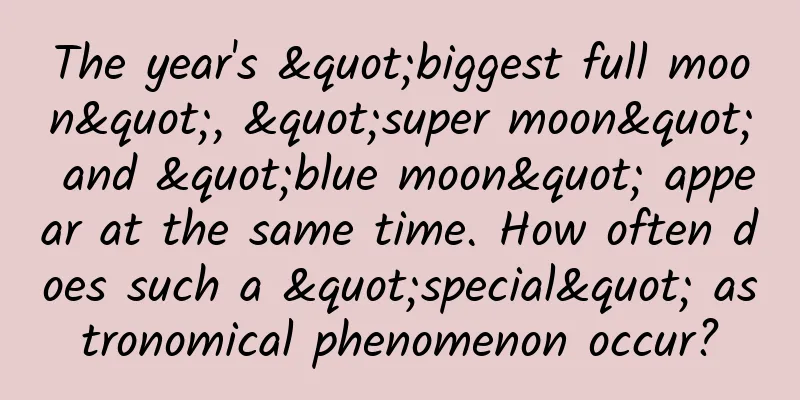The year's "biggest full moon", "super moon" and "blue moon" appear at the same time. How often does such a "special" astronomical phenomenon occur?

|
I don’t know if you have noticed that this August is quite special. We can see two full moons, one on August 2nd, and the other on August 31st. Moreover, this second full moon seems to be more "special". It is not only a full moon, but also has the triple identities of the year's "largest full moon", "super moon" and "blue moon". So the question is, how big is the annual "biggest full moon"? How often does it happen that the "biggest full moon", "super moon" and "blue moon" all come together on the same day? (Map by Science Popularization China) 1. Whether the moon is bigger or smaller cannot be seen with the naked eye The moon's orbit around the earth is elliptical. The moon's closest point to the earth is perigee, and the opposite is true at apogee. If the full moon occurs when the moon is near perigee, then the full moon at this time is the largest full moon. There is a full moon at perigee, and there is naturally a full moon at apogee. When the moon is near apogee and a full moon occurs, then this is the smallest full moon. According to calculations, the largest full moon will be larger than the smallest full moon, by about 14%, but its brightness can be 30% brighter than the smallest full moon. (Map by Science Popularization China) If you capture the smallest full moon and the largest full moon using the same photographic equipment, you can make a comparison between the two. (The largest and smallest moons in 2019, photographed and mapped by the author) However, the human eye cannot tell whether the moon is bigger or smaller. 2. The annual "biggest full moon" is actually a case of a "supermoon" After talking about the "biggest full moon", let's talk about the "super moon". Many people must be familiar with the astronomical phenomenon of "supermoon". It refers to the time when the moon is in the vicinity of perigee when it is full, and the time between the full moon and the perigee does not exceed 1 day. (Supermoon diagram, drawn by the author) This happens 2-5 times a year (if we strictly follow the definition that there is no more than 24 hours between the time of perigee and the time of full moon, there will be no more than 4 supermoons a year). Careful readers may have discovered that a "supermoon" is a full moon near perigee, and the annual "largest full moon" is also a full moon near perigee, which seems to be the same thing. So, is a "supermoon" completely equivalent to the annual "largest full moon"? Let's use a chart to explain. (See the watermark in the lower right corner for the image source) In the chart above, the hollow circles represent full moons. You can see that this year’s four supermoons are all concentrated in July-September: July 2-3: Full Moon 361,934 km from Earth August 2: Full Moon 357,530 km from Earth August 30-31: Full Moon 357,344 km from Earth September 28-29: Full Moon 361,552 km from Earth (Map by Science Popularization China) From the above data, it is not difficult to conclude that the super full moon on August 31 is the full moon closest to the earth this year, that is, the largest full moon this year. The so-called annual "largest full moon" is just one of the "super moons" that occur more than once a year. However, because the moon moves over time and the Earth and the moon are spherical, it is debatable whether observers on Earth are closest to the moon on August 31. 3. “Blue Moon” is not a blue moon. Is there really a blue moon? After so many years of popular science, I believe many people have understood that the "blue moon" is not actually a blue moon, but two full moons in a calendar month, and the second full moon will be called a "blue moon". (Map by Science Popularization China) Since the lunar cycle is 29.5 days, slightly shorter than the average length of a calendar month, this will eventually result in a full moon at the beginning and end of the month. That is, if there is a full moon on the 1st or 2nd day of the month, there is a high probability that there will be a full moon again on the 30th or 31st day of the month. This happens about every two to three years. The last blue moon was on October 31, 2020. If you miss the blue moon on August 31, you will have to wait until May 31, 2026, and the next one will be on December 31, 2028. However, in very rare cases, due to the influence of certain special substances in the atmosphere, the moon may appear pale blue. For example, after a volcanic eruption or forest fire, volcanic ash or smoke in the atmosphere may make the moon appear pale blue, which is not a true "blue moon". 4. The annual "biggest full moon", "super moon" and "blue moon" are three in one, just an ordinary coincidence From the previous introduction, we know that a "supermoon" is a full moon when the moon is near perigee, the annual "biggest full moon" is the "supermoon" closest to the earth, and a "blue moon" is when there are two full moons in one month. They don't always occur at the same time. About 25% of full moons are "supermoons," but only 3% are "blue moons." (Map by Science Popularization China) Therefore, the probability of a "super moon" and a "blue moon" occurring at the same time is not high. The time between "super blue moons" is very irregular, and can be as long as 20 years, but generally speaking, the average is 10 years. The last "super blue moon" occurred in March 2018. If you miss the observation this month, the next "super blue moon" will appear in pairs in January and March 2037. "Blue Moon" is just a concept originated in the West and has little meaning. "Super Moon" (full moon near perigee) is just the law of the moon's movement, and people don't need to worry about anything strange happening. 5. The best time to observe this full moon and how to photograph the moon The full moon time of the "supermoon" on August 31 is 09:35 Beijing time on August 31, and the perigee time is 23:51 on August 30, and the time between the two is no more than 24 hours. Therefore, if you want to observe the supermoon on August 31, the best time is in the early morning of August 31. Because the full moon is very bright, observers do not need to go to places with less light pollution, but can observe it in an open area. Now many mobile phones can directly take pictures of the moon, and you can also set up a telescope to observe and take close-up pictures of the details of the moon. If you just want to photograph the full moon, you don't have to take a super full moon. Full moons at other times can also be used. If you want to take a photo of the moon with a large effect, you can find a time when the full moon is on the horizon. For example, you can take a photo of the moon rising after sunset on August 30, or take a photo of the moon falling on the horizon before sunrise on the morning of August 31. Find a telescope or a telephoto lens and take a photo of the moon and the building together. How big the moon can be photographed depends on the focal length of the telescope or telephoto lens used. Produced by: Science Popularization China Author: Yuan Fengfang, Director of Science Communication, National Astronomical Observatories, Chinese Academy of Sciences Reviewer: Cai Yifu, Professor of Astronomy, School of Physics, University of Science and Technology of China Producer: China Science and Technology Digital Media Co., Ltd. |
<<: Do you know how hard passion fruit works to be eaten by you?!
>>: Is the Dark Star reliable? Explaining hypersonic vehicles
Recommend
An egg falling from a high altitude can kill a person, so why can a cat jump from the 32nd floor and survive?
Editor’s Note: Please do not conduct any tests or...
One out of every two adults has this real "secret"!
Studies have shown that bad breath has become the...
Bidding promotion: How to optimize core words and effectively manage keywords?
We have compiled a list of common bidding problem...
China Association of Automobile Manufacturers: A brief analysis of the sales of the top ten automobile manufacturers from January to September 2022
According to statistics and analysis by the China...
Apple announced that this year's WWDC will be held on June 3, and the new system is coming
Apple announced today that the 30th Worldwide Dev...
A piece of sugar cane was eaten and sent to the ICU! Don't eat this kind of sugar cane, it can cause death
In winter, bundles of sugar cane are often seen i...
Deep understanding of pathfinding algorithms in games
If you have played MMOARPG games, such as World o...
Content operation, do you know the strategies of these four important links?
This is an era of information overload. Even very...
Drinking less alcohol can reduce harm? Many people don’t know this…
Reviewer of this article: Chen Haixu, Deputy Dire...
Why is an article that was ravely praised on Zhihu being criticized to death on Toutiao?
What would it be like if you had an article that ...
How can brands leverage marketing opportunities on Labor Day?
For a company, there are never enough festivals, ...
The fifth anniversary of Juhe, a data carnival for developers
With the rapid development of mobile Internet, te...
Let lightning generate electricity? Lightning only provides enough electricity for the world for 9 days a year...
Nowadays, our lives are inseparable from electric...
Weird hypothermia: from agitation to hallucinations
Nowadays, the climate in many parts of the world ...
Is the popular “private domain traffic” really that powerful?
Private domain traffic should be one of the hotte...









